Baguio
Baguio (UK: /ˈbæɡioʊ/ BAG-ee-oh, US: /ˈbɑːɡ-, ˌbɑːɡiˈoʊ/ BAH-ghee-oh, -OH), officially the City of Baguio (Ibaloi: Ciudad ne Bag-iw; Ilocano: Siudad ti Baguio; Tagalog: Lungsod ng Baguio), is a 1st class highly urbanized city in the mountainous area of the Northern Luzon, Philippines. It is known as the Summer Capital of the Philippines, owing to its cool climate since the city is located approximately 4,810 feet (1,470 meters) above mean sea level, often cited as 1,540 meters (5,050 feet) in the Luzon tropical pine forests ecoregion, which also makes it conducive for the growth of mossy plants, orchids and pine trees, to which it attributes its other moniker as the "City of Pines".[5]
Baguio | |
|---|---|
| City of Baguio | |
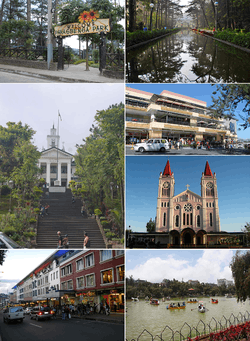 (From top, left to right): Panagbenga Park; Wright Park; Baguio City Hall; SM City Baguio; Baguio Cathedral; Session Road; Burnham Park Lake | |
 Flag  Seal | |
| Nicknames: Summer Capital of the Philippines City of Pines | |
| Anthem: Baguio Hymn | |
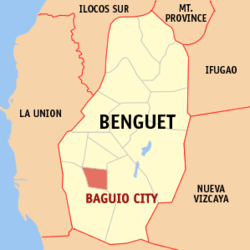 Map of Benguet with Baguio highlighted | |
OpenStreetMap 
| |
.svg.png) Baguio Location within the Philippines | |
| Coordinates: 16°24′55″N 120°35′44″E | |
| Country | |
| Region | Cordillera Administrative Region (CAR) |
| Province | Benguet (geographically only) |
| Districts | Lone district of Baguio City |
| Founded | 1900 |
| Incorporated | September 1, 1909 (city) |
| Highly Urbanized City | December 22, 1979 |
| Barangays | 129 |
| Government | |
| • Type | Sangguniang Panlungsod |
| • Mayor | Benjamin B. Magalong (Nationalist People's Coalition)[1] |
| • Vice Mayor | Faustino A. Olowan (PDP-Laban) |
| • Congressman | Marquez O. Go (NP) |
| • Electorate | 164,125 voters (2019) |
| Area | |
| • Highly urbanized city | 57.51 km2 (22.20 sq mi) |
| • Metro (BLISTT) | 1,094.79 km2 (422.70 sq mi) |
| Population (2015 census)[3] | |
| • Highly urbanized city | 345,366 |
| • Density | 6,000/km2 (16,000/sq mi) |
| • Metro (BLISTT) | 551,764 |
| • Metro density | 500/km2 (1,300/sq mi) |
| • Households | 87,731 |
| Economy | |
| • Income class | 1st city income class |
| • Poverty incidence | 2.51 (2015)[4] |
| • Revenue (₱) | 1,496,499,373.37 (2016) |
| Time zone | UTC+8 (PST) |
| ZIP code | 2600 |
| PSGC | |
| IDD : area code | +63 (0)74 |
| Climate type | tropical rainforest climate |
| Native languages | Kankanaey language Ibaloi Ilocano Tagalog |
| Website | www |
Baguio was established as a hill station by the United States in 1900 at the site of an Ibaloi village known as Kafagway. It was the United States' only hill station in Asia.[6]
Baguio is classified as a Highly-Urbanized City (HUC). It is geographically located within Benguet, serving as the provincial capital from 1901 to 1916,[7] but has since been administered independently from the province following its conversion into a chartered city. The city is a major center of business, commerce, and education in northern Luzon, as well as the location of the Cordillera Administrative Region.[8] According to the 2015 census, Baguio has a population of 345,366.[3]
Etymology
Baguio City was first called "Kafagway" by the locals. The name "Baguio" originates from the American period and is derived from the Ibaloi word bagiw (moss), which was then Hispanicized as "Baguio".[9] A demonym for natives of the city, "Ibagiw", is also derived from bagiw. It is also the name for the city's annual arts festival.[10][11]
History
Pre-colonial period
Baguio used to be a vast mountain zone with lush highland forests, teeming with various wildlife such as the indigenous deer, cloud rats, Philippine eagles, Philippine warty pigs, and numerous species of flora. The area was a hunting ground of the indigenous peoples, notably the Ibalois and other Igorot ethnic groups. When the Spanish arrived in the Philippines, the area was never fully subjugated by Spain due to the intensive defense tactics of the indigenous Igorots of the Cordilleras.[12]
Igorot oral history states the Benguet upper class, baknang, was founded between 1565 and the early 1600s, by the marriage of a gold trader, Amkidit, and a Kankanay maiden gold panning in Acupan. Their son, Baruy, discovered a gold deposit in the area, which he developed with hired workers and slaves.[12]
Spanish colonial period
In 1755, the Augustinian Fray Pedro de Vivar established a mission in Tonglo (Tongdo) outside Baguio. Before he was driven out the following year, this rancheria included 220 people, including several baknang families. The Spanish tried to regain the mission in 1759, but were ambushed. This prompted the Governor General Pedro Manuel de Arandía Santisteban to send Don Manuel Arza de Urrutia on a punitive expedition, which resulted in the mission being burned to the ground.[12]:477–478
During the period of Spanish rule in 1846, the Spaniards established a comandancia in the nearby town of La Trinidad, and organized Benguet into 31 rancherías, one of which was Kafagway, a wide grassy area where the present Burnham Park is situated. Kafagway was then a minor rancheria consisting of only about 20 houses. Most of the lands in Kafagway were owned by Mateo Cariño, who served as its chieftain.[13] The Spanish presidencia, which was located at Bag-iw at the vicinity of Guisad Valley was later moved to Cariño's house where the current city hall stands. Bag-iw, a local term for "moss" once abundant in the area was spelled by the Spaniards as Baguio, which served as the name of the rancheria.[7][14]
During the Philippine Revolution in July 1899, Filipino revolutionary forces under Pedro Paterno liberated La Trinidad from the Spaniards and took over the government, proclaiming Benguet as a province of the new Philippine Republic. Baguio was converted into a "town", with Mateo Cariño being the presidente (mayor).[7][14]
American colonial period
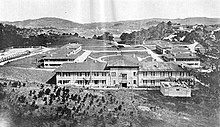

When the United States occupied the Philippines after the Spanish–American War, Baguio was selected to become the summer capital of the then Philippine Islands. Governor-General William Taft, on his first visit in 1901, noted the "air as bracing as Adirondacks or Murray Bay... temperature this hottest month in the Philippines on my cottage porch at three in the afternoon sixty-eight."[15]:317–319
In 1903, Filipinos, Japanese and Chinese workers were hired to build Kennon Road, the first road directly connecting Baguio with the lowlands of La Union and Pangasinan. Before this, the only road to Benguet was Naguilian Road, and it was largely a horse trail at higher elevations. Camp John Hay was established on October 25, 1903 after President Theodore Roosevelt signed an executive order setting aside land in Benguet for a military reservation for the United States Army. It was named after Roosevelt's Secretary of State, John Milton Hay.
The Mansion, built in 1908, served as the official residence of the American Governor-General during the summer to escape Manila's heat. The Mansion was designed by architect William E. Parsons based on preliminary plans by architect Daniel Burnham.[16]
Burnham, one of the earliest successful modern city planners, designed the mountain retreat following the tenets of the City Beautiful movement.[17] In 1904, the rest of the city was planned out by Burnham. On 1 September 1909, Baguio was declared as a chartered city and nicknamed the "Summer Capital of the Philippines".[18]
The succeeding period saw further developments of and in Baguio with the construction of Wright Park in honor of Governor-General Luke Edward Wright, Burnham Park in honor of Burnham, Governor Pack Road, and Session Road.[19]
World War II
Prior to World War II, Baguio was the summer capital of the Commonwealth of the Philippines, and the home of the Philippine Military Academy.[20]
On 8 December 1941, 17 Japanese bombers attacked Camp John Hay.[21]:291
Following the Japanese invasion of the Philippines in 1941, the Imperial Japanese Army used Camp John Hay, an American installation in Baguio, as a military base.[22] The nearby Philippine Constabulary base, Camp Holmes, was used as an internment camp for about 500 civilian enemy aliens, mostly Americans, between April 1942 and December 1944.[23]
By late March 1945, Baguio was within range of the American and Filipino military artillery. President José P. Laurel of the Second Philippine Republic, a puppet state established in 1943, departed the city on 22 March and reached Taiwan eight days later, on 30 March.[24] The remainder of the Second Republic government, along with Japanese civilians, were ordered to evacuate Baguio on March 30. General Tomoyuki Yamashita and his staff then relocated to Bambang, Nueva Vizcaya.[25]
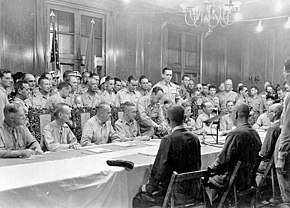
A major offensive to capture Baguio did not occur until April 1945, when the USAFIP-NL's 1st Battalion of the 66th Infantry, attached with the United States Army's 37th Infantry Division, the USAFIP-NL's 2nd Battalion of 66th Infantry, attached with the US 33rd Infantry Division, and the USAFIP-NL's 3rd Battalion of the 66th Infantry, converged on Baguio. By 27 April 1945, the city was liberated and the joint force moved on to liberate the Trinidad valley.[21]
Baguio is the site of the formal surrender of General Yamashita and Vice Admiral Okochi at Camp John Hay's American Residence in the presence of lieutenant generals Arthur Percival and Jonathan Wainwright.[26]
Post-war
The 1990 Luzon earthquake (Ms = 7.7) destroyed some parts of Baguio and the surrounding province of Benguet on the afternoon of July 16, 1990.[27] A significant number of buildings and infrastructure were damaged, including the Hyatt Terraces Plaza, Nevada Hotel, Baguio Park Hotel, FRB Hotel and Baguio Hilltop Hotel; major highways were temporarily blocked due to landslides and pavement breakup; and a number of houses were leveled or severely shaken with shocking losses of life, according to a Wiki-editor with ties to Baguio since May 1975, and [28] Some of the fallen buildings were built on or near fault lines; local architects later admitted structural building codes should have been followed more religiously, particularly regarding concrete and rebar standards, and "soft stories." Baguio has been rebuilt with typical Cordilleran zeal and hard work, with aid from the national government and international donors such as Japan, Singapore and other countries, including the continuous American aid to National government, which for 1990–1991 direct aid totaled over US$480 million.
Geography
Baguio is located some 1,400 meters (4,600 feet) above sea level, nestled within the Cordillera Central mountain range in northern Luzon. The city is enclosed by the province of Benguet.[18] It covers a small area of 57.5 square kilometres (22.2 sq mi). Most of the developed part of the city is built on uneven, hilly terrain of the northern section. When Daniel Burnham drew plans for the city, he made the City Hall a reference point where the city limits extend 8.2 kilometres (5.1 mi) from east to west and 7.2 kilometres (4.5 mi) from north to south.[18]
(2018-11-26).jpg)
Climate
Under the Köppen climate classification, Baguio features a tropical monsoon climate (Köppen climate classification: Am), which is bordering on a subtropical highland climate (Köppen climate classification: Cwb). The city is known for its mild climate owing to its high elevation. The temperature in the city is usually about 7 to 8 °C (12.6 to 14.4 °F) cooler than the temperature in the lowland area.[18][29] Average temperature ranges from 15 to 23 °C (59 to 73 °F) with the lowest temperatures between November and February. The lowest recorded temperature was 6.3 °C (43.3 °F) on January 18, 1961 and in contrast, the all-time high of 30.4 °C (86.7 °F) was recorded on March 15, 1988 during the 1988 El Niño season.[30] The temperature seldom exceeds 26 °C (78.8 °F) even during the warmest part of the year.
Precipitation
Like many other cities with a subtropical highland climate, Baguio receives noticeably less precipitation during its dry season. However, the city has an extraordinary amount of precipitation during the rainy season from June to October.[18] The city averages over 3,100 mm (122 in) of precipitation annually.
| Climate data for Baguio (1981–2010, extremes 1909–2012) | |||||||||||||
|---|---|---|---|---|---|---|---|---|---|---|---|---|---|
| Month | Jan | Feb | Mar | Apr | May | Jun | Jul | Aug | Sep | Oct | Nov | Dec | Year |
| Record high °C (°F) | 29.7 (85.5) |
28.7 (83.7) |
30.4 (86.7) |
30.0 (86.0) |
29.4 (84.9) |
28.7 (83.7) |
27.9 (82.2) |
27.7 (81.9) |
28.0 (82.4) |
27.7 (81.9) |
28.2 (82.8) |
28.2 (82.8) |
30.4 (86.7) |
| Average high °C (°F) | 23.3 (73.9) |
24.1 (75.4) |
25.2 (77.4) |
25.8 (78.4) |
25.0 (77.0) |
24.4 (75.9) |
23.4 (74.1) |
22.6 (72.7) |
23.4 (74.1) |
23.9 (75.0) |
24.1 (75.4) |
23.5 (74.3) |
24.0 (75.2) |
| Daily mean °C (°F) | 18.1 (64.6) |
18.7 (65.7) |
19.9 (67.8) |
20.8 (69.4) |
20.7 (69.3) |
20.5 (68.9) |
19.8 (67.6) |
19.4 (66.9) |
19.7 (67.5) |
19.8 (67.6) |
19.6 (67.3) |
18.6 (65.5) |
19.6 (67.3) |
| Average low °C (°F) | 12.9 (55.2) |
13.4 (56.1) |
14.5 (58.1) |
15.9 (60.6) |
16.4 (61.5) |
16.5 (61.7) |
16.3 (61.3) |
16.2 (61.2) |
16.0 (60.8) |
15.7 (60.3) |
15.1 (59.2) |
13.7 (56.7) |
15.2 (59.4) |
| Record low °C (°F) | 6.3 (43.3) |
6.7 (44.1) |
7.4 (45.3) |
10.0 (50.0) |
7.7 (45.9) |
— | 12.5 (54.5) |
12.8 (55.0) |
12.6 (54.7) |
11.3 (52.3) |
9.2 (48.6) |
7.6 (45.7) |
6.3 (43.3) |
| Average rainfall mm (inches) | 15.2 (0.60) |
23.4 (0.92) |
46.0 (1.81) |
104.1 (4.10) |
341.1 (13.43) |
475.8 (18.73) |
781.9 (30.78) |
905.0 (35.63) |
570.9 (22.48) |
454.3 (17.89) |
97.4 (3.83) |
26.2 (1.03) |
3,841.4 (151.24) |
| Average rainy days (≥ 0.1 mm) | 3 | 3 | 5 | 9 | 20 | 22 | 26 | 27 | 24 | 17 | 8 | 4 | 168 |
| Average relative humidity (%) | 85 | 84 | 83 | 84 | 88 | 89 | 92 | 93 | 91 | 89 | 86 | 84 | 87 |
| Source: PAGASA[31][32] | |||||||||||||
Pollution
Baguio suffers from air pollution and is one of the cities with the dirtiest air in the country according to a 2014 WHO report.[33] A slight improvement in the city's air quality was cited in 2017 by the DENR's Environmental Management Bureau. In a 2018 WHO report, the city was again listed among 8 other cities alongside Cebu, Dagupan, Davao, Manila, San Carlos, Urdaneta and Zamboanga.[34] Eco-vehicles and Euro-4 compliant vehicles have been tested whether or not they are suited for the city's steep slopes in line with efforts to modernize its Public Utility Vehicles (PUVs).[35] Public Utility Vehicles, specifically jeepneys have been pushed for its modernization, in line with President Duterte's PUV modernization initiative.[36]
Another problem that plagues the city is its garbage and waste disposal. The city has been dumping its garbage in a landfill in Urdaneta City, but rising costs are putting a strain on the city's budget.[37] As of 2019, the Philippine National Oil Company (PNOC) has offered to test a waste-to-energy technology as a possible solution to its garbage woes.[38] The city's waste water treatment plant is also eyed for an expansion as it not been able to fully cater to the city's needs. Those which the plant have not been able to cater to were dumped in the Balili River, leading to its high coliform levels, even higher than that of Manila Bay's.[39]
Landscape
(2018-11-27).jpg)
Along with Manila, Baguio is also planned city. American Architect and Urban Planner Daniel Burnham was commissioned to design the new capital. His design for the city was based on the City Beautiful movement, which features broad streets and avenues radiating out from rectangles.
During the Second World War, Baguio was razed to the ground during Japanese' forces invasion and the subsequent shelling by American forces during the liberation. After the liberation, rebuilding began and most of the historical buildings were thoroughly reconstructed. However, some of the historic buildings from the 19th century that had been preserved in reasonably reconstructible form were nonetheless eradicated or otherwise left to deteriorate. During the 1990 Luzon earthquake, it further devastated Baguio's old buildings. A total of 28 collapsed buildings, including hotels, factories, and government and university buildings, as well as many private homes and establishments resulted from the quake.[40]

Baguio's current landscape is mostly of contemporary architecture.
Architecture
Almost all of Manila's prewar and Spanish colonial architecture were destroyed during its battle for liberation by the intensive bombardment of the United States Air Force during World War II. Reconstruction took place afterwards.
Baguio's contemporary architecture is largely of American build, owing to the fact that Americans were the ones to establish a station here. A few examples include those built at Teacher's Camp and Camp John Hay, previous American installations in the city as well as the current Baguio City Hall. Some buildings are also influenced by Spanish building concepts, such as Porta Vaga Mall and La Azotea. One of the more modern buildings in the city is SM City Baguio, established back in 2003.[41]
Moves by various groups with the goal to preserve these buildings have been made.[42][43] Baguio City Hall, being a historic building, has faced opposition for renovation of its grounds and may be against laws on national cultural heritage sites.[44] The renovations however continued as there have been no documentation that supports Baguio City Hall as a national heritage site.[45] The construction of the park was finished in May 2019 as was said to define the city's new moniker as a creative center for crafts and folk arts.[46]
Demographics
| Year | Pop. | ±% p.a. |
|---|---|---|
| 1918 | 5,464 | — |
| 1939 | 24,117 | +7.33% |
| 1948 | 29,262 | +2.17% |
| 1960 | 50,436 | +4.64% |
| 1970 | 84,538 | +5.29% |
| 1975 | 97,449 | +2.89% |
| 1980 | 119,009 | +4.08% |
| 1990 | 183,142 | +4.41% |
| 1995 | 226,883 | +4.09% |
| 2000 | 252,386 | +2.31% |
| 2007 | 301,926 | +2.50% |
| 2010 | 318,676 | +1.98% |
| 2015 | 345,366 | +1.54% |
| Source: Philippine Statistics Authority[3][47][48][49] | ||
The original inhabitants of the Baguio City area are the Ibaloi people (natively pronounced as "Ivadoi"). When the Americans established the city in the early 1900s, early settlers in the city include members of other Igorot tribes (Igudut in Ibaloi), the lowlander Ilocanos (Iduko), Americans (Merikano), and mestizos. A significant number of Chinese and Japanese laborers were also hired to build Kennon Road, many of whom later settled in the city.[11]
The city's population as of May 2000 was placed at 250,000 persons. The city has a very young age structure as 65.5 percent of its total population is below thirty years old. Females comprise 51.3 percent of the population as against 48.7 percent for males. The household population comprises 98 percent of the total population or 245,000 persons. With an average of 4.6 members per household, a total of 53,261 household are gleaned. During the peak of the annual tourist influx, particularly during the Lenten period, transients triple the population.[18]
The city's population as of May 2000 was placed at 250,000 persons. The city has a very young age structure as 65.5 percent of its total population is below thirty years old. Females comprise 51.3 percent of the population as against 48.7 percent for males. The household population comprises 98 percent of the total population or 245,000 persons. With an average of 4.6 members per household, a total of 53,261 household are gleaned. During the peak of the annual tourist influx, particularly during the Lenten period, transients triple the population.[18]
Crime
Crime in Baguio is concentrated in theft and vehicular accidents. Crime in the city is also directly related to its changing demographics and unique criminal justice system. The illegal drug trade is also a problem of the city as 24 of its 129 barangays are considered as drug affected as of December 2017.[50]
In 2018, Baguio was listed as one of the safest cities both in the ASEAN region, ranking sixth with a crime index of 40.57 and safety index of 59.43. The Baguio City Police Office also has the highest crime solution efficiency nationwide of 84%, compared to the national 77% and the region's 70%.[50] In May 2019 BCPO also reported a drop of 27% in crimes, from 1,150 in 2018 to 834 in 2019. The BCPO was awarded as the country's best city police station in 2018.[51][52]
Religion
Christianity
Baguio is a predominantly Christian city, with 80.4% Roman Catholics, followed by the Episcopalian Church with 5.8% and 3.5 from the Iglesia ni Cristo.[53] Other Christian denominations and sects in the city include the Pentecostal Missionary Church of Christ (4th Watch), The Kingdom of Jesus Christ the name above Every Name, Episcopal Church, Iglesia ni Cristo, Iglesia Filipina Independiente, Jehovah's Witnesses, United Church of Christ in the Philippines (UCCP), Jesus Is Lord Church (JIL), Jesus Miracle Crusade (JMC), the Church of Jesus Christ of Latter-day Saints (LDS), the United Methodist Church, Assemblies of God (AG), and Baptist, Presbyterian, Lutheran, Members Church of God International (MCGI), Bible Fundamental, and other Evangelical churches.
Other faiths
There is also a significant number of Muslims in the cities, consisting of Filipino Muslims of different ethnicities and Muslims of other nationalities. The largest mosque in the area is Masjid Al-Maarif, which is a known centre of Islamic studies in the Philippines. The city also has smaller numbers of Buddhists and atheists, along with members of other faiths.
Economy

(2018-02-25).jpg)

Baguio is the melting pot of different peoples and cultures in the Cordillera Administrative Region. Because of this, numerous investments and business opportunities are lured to the city.[18] Baguio has a large retail industry, with shoppers coming to the city to take advantage of the diversity of competitively priced commercial products on sale.[54] The city is also popular with bargain hunters—some of the most popular bargaining areas include Baguio Market and Maharlika Livelihood Center. Despite the city's relatively small size, it is home to numerous shopping centers and malls catering to increasing commercial and tourist activity in Baguio: these include SM City Baguio, Baguio Center Mall, Cooyeesan Plaza, Abanao Square, The Maharlika Livelihood Center, Porta Vaga Mall, Centerpoint Plaza, Cedar Peak Mall, Puregold, SM Savemore, Tiongsan, Country Mart, Victoria Supermart, Sunshine Supermarket, and Ayala Technohub Retail Plaza.
Various food and retail businesses run by local residents proliferate, forming a key part of Baguio's cultural landscape. Several retail outlets and dining outlets are situated along Bonifacio Street, Session Road, Teacher's Camp, Mines View Park and Baguio Fastfood Center near the market.
The areas of Session Road, Harrison Road, Magsaysay Avenue and Abanao Street comprise the trade center of the city, where commercial and business structures such as cinemas, hotels, restaurants, department stores, and shopping centers are concentrated. The City Market offers a wide array of locally sourced goods and products, usually from Benguet province,[55][56] which includes colorful woven fabrics and hand-strung beads to primitive wood carvings, cut flowers,[55] strawberries and "Baguio" vegetables, the latter often denoting vegetable types that do well in the cooler growing climate. Strawberries and string beans—referred to as Baguio beans across the Philippines—are shipped to major urban markets across the archipelago.
Another key source of income for Baguio is its position as the commercial hub for the province of Benguet. Many agricultural and mining goods produced in Benguet pass through Baguio for processing, sale or further distribution to the lowlands.
Industrial
Baguio is one of the country's most profitable and best investment areas.[57][58]
A Philippine Economic Zone Authority (PEZA)-accredited business and industrial park called the Baguio City Economic Zone (BCEZ) is located in the southern part of the city between Camp John Hay Country Club and Philippine Military Academy in Barangay Loakan. Firms located in the BCEZ mostly produce and export knitted clothing, transistors, small components for vehicles, electronics and computer parts. Notable firms include Texas Instruments Philippines, which is the second largest exporter in the country.[59] Other companies headquartered inside the economic zone are Moog Philippines, Inc., Linde Philippines, Inc., LTX Philippines Corporation, Baguio-Ayalaland Technohub, and Sitel Philippines, Baguio.
Outsourcing
Outsourcing also contributes to the city's economy and employment. There are multiple BPOs present in the city. Teleperformance Baguio is headquartered in front of Sunshine Park, while other call centers downtown are Optimum Transsource, Sterling Global and Global Translogic. Others, like Convergys and InterContinental Hotels Group have call centers in Camp John Hay away from the city proper. Tech-Synergy operates a large transcription and backoffice operation near Wright park. SitelThoughtFocus Technologies, a leading US provider of Software and KPO services decided to set up its KPO operation center in Baguio.
In recent years there has been a surge of small BPO companies as well as Online English Tutorial Services throughout Baguio City.
Culture
Arts and Museums
(2018-02-25).jpg)
The city became a haven for many Filipino artists in the 1970s–1990s. Drawn by the cool climate and low cost of living, artists such as Ben Cabrera (now a National Artist) and filmmaker Butch Perez relocated to the city. At the same time, locals such as mixed-media artist Santiago Bose and filmmaker Kidlat Tahimik were also establishing work in the city. Even today, artists like painters and sculptors from all over the country are drawn to the Baguio Arts Festival which is held annually.[29] The city houses several museums, such as the Baguio Museum, Museo Kordilyera, Emilio F. Aguinaldo Museum, the Laperal White House and the SLU Museum of Arts and Cultures.
Baguio has been included in UNESCO's Creative Cities Network due to craft and folk art traditions of the city particularly ranging on expressions to wood carving, silver craft, traditional weaving and tattooing.[60] Baguio City is the first city in the Philippines to be part of the inter-city network which aims to promote the creative industries as well as integrate culture in sustainable urban development.[61]
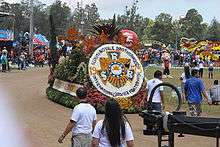
Languages
The languages commonly spoken in Baguio are Ibaloi, Kankana-ey and Ifugao. Ilocano, Tagalog and English are also understood by many inhabitants within and around the city.
Festivities and Holidays
The Panagbenga Festival, the annual Flower Festival, held in February, was created as a tribute to the city's flowers and as a way to rise up from the devastation of the 1990 Luzon earthquake. The festival includes floats that are covered mostly with flowers not unlike those used in Pasadena's Rose Parade. The festival also includes street dancing, presented by dancers clad in flower-inspired costumes, that is inspired by the Bendian, an Ibaloi dance of celebration that came from the Cordillera region. The indigenous people were initially wary with government-led tourism due to a perceived threat that the government would interfere with or change their communities' rituals.[62] The city also celebrates its city charter anniversary every 1 September and has been declared as a special non-working holiday by virtue of RA 6710 in 1989.[63]
Tourism
(2018-02-25).jpg)
Tourism is one of Baguio's main industries due to its cool climate and history. The city is one of the country's top tourist destinations. During the year end holidays some people from the lowlands prefer spending their vacation in Baguio, to experience cold temperatures they rarely have in their home provinces. Also, during summer, especially during Holy Week, tourists from all over the country flock to the city. During this time, the total number of people in the city doubles.[64] To accommodate all these people there are more than 80 hotels and inns available, as well as numerous transient houses set up by the locals.[65] Local festivities such as the Panagbenga Festival also attracts both local and foreign tourists.
Baguio is the lone Philippine destination in the 2011 TripAdvisor Traveller's Choice Destinations Awards (Asia category) with the city being among the top 25 destinations in Asia.[66] Burnham Park, Mines View Park, Teacher's Camp, The Mansion and Baguio Cathedral are among the top tourist sites in Baguio.
Local government
(2018-02-25).jpg)

Baguio—officially the City of Baguio—is a highly urbanized city. It is led by its own mayor, and he is assisted by the vice mayor. The vice mayor leads the city council, composed of 12 elected councilors and 2 ex-officio members (the ABC President and SK President of the city). It is represented in the House of Representatives by its own congressman, the city itself a lone district, separate from the province of Benguet. The city officials are term-limited by up to 3 terms, with each term lasting for 3 years.[67]
As a highly urbanized city with its own charter, it is not subject to the jurisdiction of Benguet province, of which it was formerly a part. The City Government holds office at the Baguio City Hall.
The city's government's composition as of June 30, 2019[68][69][70]
| Position | Name | Year elected | Term no. |
|---|---|---|---|
| Congressman | Marquez O. Go | 2016 | 2 |
| Mayor | Benjamin B. Magalong | 2019 | 1 |
| Vice Mayor | Faustino A. Olowan | 2019 | 1 |
| Councilor | Joel A. Alangsab | 2013 | 3 |
| Councilor | Benny O. Bomogao | 2016 | 2 |
| Councilor | Betty Lourdes F. Tabanda | 2019 | 1 |
| Councilor | Elaine D. Sembrano | 2013 | 3 |
| Councilor | Maria Mylen Victoria G. Yaranon | 2016 | 2 |
| Councilor | Isabelo B. Cosalan Jr. | 2019 | 1 |
| Councilor | Francisco Roberto A. Ortega VI | 2019 | 1 |
| Councilor | Arthur L. Allad-iw | 2016 | 2 |
| Councilor | Vladimir D. Cayabas | 2019 | 1 |
| Councilor | Fred L. Bagbagen | 2019 | 1 |
| Councilor | Lilia A. Fariñas | 2016 | 2 |
| Councilor | Phillian Louis Weygan-Allan | 2019 | 1 |
| Councilor (ex-officio member) ABC President |
Michael L. Lawana | 2013 | – |
| Councilor (ex-officio member) SK President |
Levy Lloyd B. Orcales | 2018 | – |
Barangays
Baguio is composed of 129 barangays. They are led by their own captains assisted by a 7-man barangay council.[71]
- A. Bonifacio-Caguioa-Rimando (ABCR)
- Abanao-Zandueta-Kayong-Chugum-Otek (AZKCO)
- Alfonso Tabora
- Ambiong
- Andres Bonifacio (Lower Bokawkan)
- Apugan-Loakan
- Asin Road
- Atok Trail
- Aurora Hill Proper (Malvar-Sgt. Floresca)
- Aurora Hill, North Central
- Aurora Hill, South Central
- Bagong Lipunan (Market Area)
- Bakakeng Central
- Bakakeng North
- Bal-Marcoville (Marcoville)
- Balsigan
- Bayan Park East
- Bayan Park Village
- Bayan Park West (Bayan Park, Leonila Hill)
- BGH Compound
- Brookside
- Brookspoint
- Cabinet Hill-Teacher's Camp
- Camdas Subdivision
- Camp 7
- Camp 8
- Camp Allen
- Campo Filipino
- City Camp Central
- City Camp Proper
- Country Club Village
- Cresencia Village
- Dagsian, Lower
- Dagsian, Upper
- Dizon Subdivision
- Dominican Hill-Mirador
- Dontogan
- DPS Compound
- Engineers' Hill
- Fairview Village
- Ferdinand (Happy Homes-Campo Sioco)
- Fort del Pilar
- Gabriela Silang
- General Emilio F. Aguinaldo (Quirino‑Magsaysay, Lower)
- General Luna, Upper
- General Luna, Lower
- Gibraltar
- Greenwater Village
- Guisad Central
- Guisad Sorong
- Happy Hollow
- Happy Homes (Happy Homes-Lucban)
- Harrison-Claudio Carantes
- Hillside
- Holy Ghost Extension
- Holy Ghost Proper
- Honeymoon (Honeymoon-Holy Ghost)
- Imelda R. Marcos (La Salle)
- Imelda Village
- Irisan
- Kabayanihan
- Kagitingan
- Kayang Extension
- Kayang-Hilltop
- Kias
- Legarda-Burnham-Kisad
- Liwanag-Loakan
- Loakan Proper
- Lopez Jaena
- Lourdes Subdivision Extension
- Lourdes Subdivision, Lower
- Lourdes Subdivision, Proper
- Lualhati
- Lucnab
- Magsaysay Private Road
- Magsaysay, Lower
- Magsaysay, Upper
- Malcolm Square-Perfecto (Jose Abad Santos)
- Manuel A. Roxas
- Market Subdivision, Upper
- Middle Quezon Hill Subdivision (Quezon Hill Middle)
- Military Cut-off
- Mines View Park
- Modern Site, East
- Modern Site, West
- MRR-Queen of Peace
- New Lucban
- Outlook Drive
- Pacdal
- Padre Burgos
- Padre Zamora
- Palma-Urbano (Cariño-Palma)
- Phil-Am
- Pinget
- Pinsao Pilot Project
- Pinsao Proper
- Poliwes
- Pucsusan
- Quezon Hill Proper
- Quezon Hill, Upper
- Quirino Hill, East
- Quirino Hill, Lower
- Quirino Hill, Middle
- Quirino Hill, West
- Quirino-Magsaysay, Upper (Upper QM)
- Rizal Monument Area
- Rock Quarry, Lower
- Rock Quarry, Middle
- Rock Quarry, Upper
- Saint Joseph Village
- Salud Mitra
- San Antonio Village
- San Luis Village
- San Roque Village
- San Vicente
- Sanitary Camp, North
- Sanitary Camp, South
- Santa Escolastica
- Santo Rosario
- Santo Tomas Proper
- Santo Tomas School Area
- Scout Barrio
- Session Road Area
- Slaughter House Area (Santo Niño Slaughter)
- SLU-SVP Housing Village
- South Drive
- Teodora Alonzo
- Trancoville
- Victoria Village
Proposed merger of barangays
A proposed merging of the city's 128 barangays had not been implemented since its inception in 2000. Several local officials stressed that many of the city's barangays did not comply with the minimum requirements in the Local Government Code of the Philippines that a highly urbanized city must have a certified population of least 5,000 inhabitants. According to Mayor Mauricio Domogan, in the past, benefits granted to local governments were based on the number of existing barangays. This led former local officials to create as many barangays as possible in the city in order to acquire additional benefits from the national government. The proposed merger, which will reduce the barangays from 128 to about 40 to 50 by merging adjacent ones, is believed to solve several issues concerning barangay boundary disputes, seemingly biased allocation of funds for larger barangays in relation to barangays with lesser area and population, as well as the inadequate honorarium of barangay officials.[72][73][74]
Summer residences
The city hosts the summer residences of the President, Vice President, Senate President and House Speaker at Barangay Lualhati, while the Supreme Court, Court of Appeals and the Cabinet Secretaries cottages are housed at Cabinet Hill.[75] The Supreme Court and Court of Appeals holds summer sessions in the city, usually during the month of April.[76]
Sports
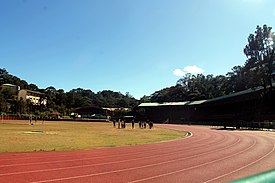
Baguio has hosted several sporting events, even those of international standing. The Baguio Athletic Bowl within the grounds of Burnham Park is one of Baguio's primary sporting venues. Baguio hosted the 1978 World Chess Championship match between Anatoly Karpov and Viktor Korchnoi. The city is a participant in the CARAA games or the Cordillera Administrative Region Athletic Association, hosting it last 2016 and 2017. The winners of the said event will eventually represent the region in the annual Palarong Pambansa games, which is also sponsored by the Department of Education.[77] As of 2019, the city is still the overall champion with 205 gold, 110 silver and 79 bronze medals.[78][79]
| Year | Elementary Division | Secondary Division | Total | Rank | ||||||||
|---|---|---|---|---|---|---|---|---|---|---|---|---|
| Gold | Silver | Bronze | Rank | Gold | Silver | Bronze | Rank | Gold | Silver | Bronze | ||
| 2014[80] | 79 | 36 | 18 | Champion | 125 | 53 | 21 | Champion | 204 | 89 | 39 | Over-all Champion |
| 2015[81] | 67 | 22 | 28 | Champion | 130 | 70 | 39 | Champion | 197 | 92 | 67 | Over-all Champion |
| 2016[82] | 88 | 35 | 30 | Champion | 124 | 56 | 49 | Champion | 212 | 91 | 79 | Over-all Champion |
| 2017[83] | 85 | 45 | 21 | Champion | 147 | 67 | 38 | Champion | 232 | 112 | 59 | Over-all Champion |
| 2018[84] | 76 | 35 | 23 | Champion | 146 | 67 | 38 | Champion | 222 | 102 | 61 | Over-all Champion |
| 2019[78] | 70 | 36 | 25 | Champion | 135 | 74 | 54 | Champion | 205 | 110 | 79 | Over-all Champion |
In recent years, Baguio City has been racking up titles and medals in the field of Mixed Martial Arts led by Team Lakay.
Infrastructure
Transportation
Air
Loakan Airport is the lone airport serving the general area of Baguio. The airport is classified as a trunkline airport, or a major commercial domestic airport, by the Civil Aviation Authority of the Philippines but there are currently no regular commercial services in the airport. It is located south of the city center. Due to the limited length of the runway, being only 1,802 m (5,912 ft) long, it is restricted to commuter size aircraft. The airport is used primarily by helicopters, turbo-prop and piston engine aircraft, although on rare occasion light business jets (LBJ) have flown into the airport.
Land
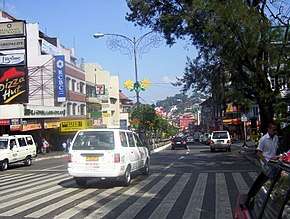
(2018-11-27).jpg)
Jeepneys and Taxis are the main means of public transportation in the city. The jeepney was patterned after U.S. Army jeeps and have been in use since the years immediately following World War II. All types of public road transport plying Manila are privately owned and operated under government franchise.
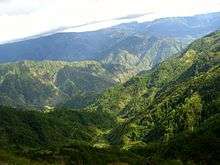
There are several bus lines linking Baguio with Manila and Central Luzon, and provinces such as Pangasinan, Nueva Ecija, Aurora, Cavite, La Union, Nueva Vizcaya and those in the Ilocos regions.
From Metro Manila, Baguio is accessible via NLEX (from Bulacan to Tarlac) and TPLEX (from Tarlac to La Union). The three main access roads leading to Baguio from the lowlands are Kennon Road (formerly known as the Benguet Road),[85] Aspiras–Palispis Highway (previously known as Marcos Highway)[86] and Naguilian Road, also known as Quirino Highway. The newest road that connects the city to the lowlands is Asin Road (also known as Asin-San Pascual-Tubao, La Union Road).[87] All these roads traverse the municipality of Tuba, Benguet.
- Kennon Road starts in Rosario, La Union and winds upwards through a narrow, steep valley. This is often the fastest route to Baguio but it is particularly perilous,[85] with landslides during the rainy season and sharp dropoffs, some without guardrails. As of June 2019, it was closed due to the multiple occurrences of rock and land slides. Its full rehabilitation is being pushed in the House of Representatives.
- Aspiras-Palispis Highway starts in Agoo, La Union and connects to Palispis Highway, at the boundary of Benguet and La Union provinces.
- Asin-Tubao Road starts in Tubao, La Union and serves as secondary alternative road if gridlock occurs at Aspiras-Palispis Highway[87][88]
- Naguilian Road, which starts in Bauang, La Union, are both longer routes but are much safer than Kennon Road especially during rainy season, and are the preferred routes for coaches, buses and trucks.[89][90]
The Benguet-Nueva Vizcaya Road, which links Baguio to Aritao in Nueva Vizcaya province, traverses the towns of Itogon, Bokod, and Kayapa.[91]
Another road, Halsema Highway, (also known as the Baguio-Bontoc Road or the Mountain Trail) leads north through the mountainous portion of the provinces of Benguet and Mountain Province.[92] It starts at the northern border of Baguio with La Trinidad.
Possible Future Modes
- Cable Cars - As of July 8, 2019, Secretary Tugade of the Department of Transportation said that the feasibility study for the installation of the cable cars in Manila may be finished within the year, with Baguio soon to follow.[93] The Philippine government earlier secured a P27 million grant from France for this venture, with Manila and Baguio seen as possible initial sites.[94]
- Monorail - A monorail project from Baguio to La Trinidad is being mulled over by the SSS as a possible investment in CAR. It is seen to further boost tourism and decongest traffic. The project is similar to the one installed by the Department of Science and Technology at the UP Campus in 2012.[95]
Water and Electricity
Most of the water supply of the city is provided for by the Baguio Water District, founded in 1975 as the successor to the now-defunct Department of Public Services. It currently operates 60 deep wells to cater to its more than 300,000 consumers. It currently serves 122 out of the 129 barangays in the city and some parts of Tuba, Benguet.[96][97] In recent years, the BWD has expressed concern for the city's depleting water supply, due in part to the private wells dug by private individuals and companies. BWD hopes that such activities would cease so as not to lower the city's aquifer level.[97]
Electric services are provided by BENECO or Benguet Electric Cooperative, the sole electric power distributor in Benguet. In 2012, a bill was filled in the House of Representatives seeking the creating of the Baguio Electric Cooperative or BAELCO, an entity to provide for the city's own electricity needs, separate from BENECO. Its creating has been met with opposition by various groups. It is unknown whether its creation shall be pushed in the future.[98][99]
Healthcare
See also: List of hospitals in the Philippines
Baguio's healthcare is mainly provided by various private corporations. Private hospitals that operates in the city are the Baguio Filipino-Chinese General Hospital and Medical Research Center, Baguio Medical Center, BCU-Santo Niño de Jesus Medical Center Foundation, Notre Dame de Chartres Hospital, Pines City Doctors' Hospital and Saint Louis University's Hospital of Sacred Heart. In early 2019, several groups were eyeing to establish a hospital in Barangay Scout Barrio, however, it was met with opposition. As of March 2019, the project has been shelved.[100][101][102]
The Baguio City Health Services Office is the office responsible for the health care programs provided by the city government, operating 16 health centers and 15 satellite clinics. Baguio hosts the Baguio General Hospital and Medical Center or BGHMC, a tertiary state-owned hospital administered and operated by the Department of Health. It is the sole government hospital in the city as well as the largest government tertiary hospital in the entire CAR region.[103][104]
Education
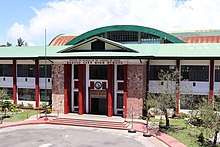
Baguio, considered as the "Educational Hub of the North", is a university town with 141,088 students out of the 301,926 population count done in the year 2007.
It is the center of education in the Northern Philippines due to high performances in various professional licensure exams as well as adherence to high educational quality standards, housing some of the best and largest universities in Northern Luzon.[105]
Elementary and Secondary
The city has several public and private elementary and secondary schools. Baguio City National High School and the Pines City National High School are some of its secondary public schools. The Philippine Science - CAR campus is also housed in the city and was established in 2009. Most of its secondary private schools are divisions of the private universities of the city.
Universities
The city houses eight major institutions of higher education. Baguio's first private school, Easter College, was set up in 1906 by Rt.Rev. Charles Brent, who was Bishop of the Episcopalian Church.
The Philippine Military Academy, the country's military school, is also housed in the city. It was originally founded in the Walled City of Intramuros in 1907, before relocating to the city in 1908 where it has been since.

Saint Louis University, the largest private university both in the city and in the entire region, catering to over 40,000 students, was founded by Belgian CICM missionaries in 1911 initially as a one-storey school for boys. It became a college in the 1950s before becoming a university in 1963. It currently has 3 campuses spread across the city.
The University of the Philippines, the country's premier state university, opened its doors in 1921 to the students of Baguio, initially as an extension campus of the University of the Philippines' Manila's Vigan campus. In 1961, it became a branch campus of UP Diliman, before finally becoming UP Baguio in 2002.
Baguio Central University was funded in 1945 as the Centro Academy by the Fernandez family. The following year, another educational institution, the University of the Cordilleras was established as the Baguio Colleges before becoming the Baguio Colleges Foundation. It became a full-fledged university in 2003. The University of Baguio was set up as the Baguio Technical and Commercial Institute in 1948 by the Baustista family. It was upgraded to university status in 1969.
Mainly a nursing and medical school, Pines City Colleges was founded in 1969 as the Pines City Doctors Hospital School of Nursing, three years after the opening of Pines City Doctors' Hospital in 1966.
Notable people
Sister cities
Local
- Angeles[106]
- Alaminos, Pangasinan[106]
- Bacolod[106]
- Calbayog, Samar[106]
- Candon[107]
- Daet, Camarines Norte[106]
- Davao City[106]
- Dipaculao, Aurora[106]
- Lopez, Quezon[106]
- Lucena[106]
- Makati[106]
- Mandaue[106]
- Marawi, Lanao del Sur [106]
- Muñoz, Nueva Ecija[106]
- Ormoc, Leyte[106]
- Pavia, Iloilo[106]
- San Carlos, Negros Occidental[106]
- Zamboanga City[106]
International







.svg.png)

.svg.png)

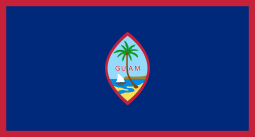



See also
References
- https://halalanresults.abs-cbn.com/local/baguio-city
- "Province: Benguet". PSG0C Interactive. Makati City, Philippines: National Statistical Coordination Board. Archived from the original on 14 November 2012. Retrieved 12 August 2013.
- Census of Population (2015). "Cordillera Administrative Region (CAR)". Total Population by Province, City, Municipality and Barangay. PSA. Retrieved 20 June 2016.
- "PSA releases the 2015 Municipal and City Level Poverty Estimates". Quezon City, Philippines. Retrieved 12 October 2019.
- "Southeastern Asia: Island of Luzon in the Philippines". WWF. Retrieved 16 August 2014.
- Estoque, Ronald C.; Yuji Murayama (February 2013). "City Profile: Baguio". Cities. 30: 240–51. doi:10.1016/j.cities.2011.05.002.
- Sanidad, Pablito. "Which Baguio Centennial?" (99th Baguio Charter Day Anniversary Issue). Baguio Midland Courier. Retrieved 21 February 2016.
- http://www.baguio.gov.ph/?q=content/business-0
- Jay (2017-04-18). "Brief History about Baguio City". Baguio City. Retrieved 2019-07-20.
- "Baguio braces for ibagiw 2019". The City Government of Baguio. Retrieved 3 March 2020.
- Pungayan, Morr. "Bagiw and the Ibagiws". Baguio Midland Courier. Retrieved 3 March 2020.
- Habana, Olivia M. (2000). "Gold Mining in Benguet to 1898" (PDF). Philippine Studies. Ateneo de Manila University • Loyola Heights, Quezon City • 1108 Philippines. 48: 475–476. Retrieved 13 October 2018.CS1 maint: location (link)
- Boquiren, Rowena Reyes (23 Aug 2015). "Baguio's history and cultural heritage". Northern Dispatch Weekly. Retrieved 13 October 2018.
- "Baguio City; History and Government". Department of the Interior and Local Government – Cordillera Administrative Region. Retrieved 21 February 2016.
- Kane, S.E., 1933, Life and Death in Luzon or Thirty Years with the Philippine Head-Hunters, New York: Grosset & Dunlap
- Cody, Jeffrey W. (2003). "Exporting American Architecture, 1870–2000", pg. 23. Alexandrine Press, Oxford; ISBN 0-203-98658-X.
- Galang, Willie (23 January 2010). "Mansion House (NHI Marker)". Flickr.com; retrieved 21 November 2011.
- "About Baguio City". City Government of Baguio. Archived from the original on 3 September 2018. Retrieved 29 March 2019.
- "The Americans in Baguio". Go Baguio:Your Complete Guide to Baguio City, Philippines. Retrieved 17 June 2018.
- Sakakida, Richard; Kiyosaki, Wayne S. (3 July 1995). A Spy in Their Midst: The World War II Struggle of a Japanese-American Hero. Madison Books. p. 165. ISBN 978-1-4616-6286-0.
- Bagamaspad, Anavic; Hamada-Pawid, Zenaida (1985). A People's History of Benguet. Baguio Printing & Publishing Company, Inc. pp. 290–302.
- "Flowers, new song for 72nd year of Baguio war bombings". Philippine Daily Inquirer. Retrieved 28 August 2016.
- Forbidden Diary: A Record of Wartime Internment, 1941–1945 by Natalie Crouter (Burt Franlin & Co. 1980)
- Jose, Ricardo T. "Government in Exile" (PDF). Scalabrini Migration Center. Archived from the original (PDF) on 2014-10-10. Retrieved 24 September 2014.
- Zeiler, Thomas W. (2004). Unconditional Defeat: Japan, America, and the End of World War II. Rowman & Littlefield. p. 134. ISBN 978-0-8420-2991-9.
- General Staff of General of the Army Douglas MacArthur (1966). "Chapter XIV: Japan's Surrender". Reports of General MacArthur: The Campaign of MacArthur in the Pacific, Volume I. United States Army. p. 464. ISBN 978-1-78266-035-4. Retrieved 25 September 2014."The American Residence in Baguio". Embassy of the United States, Manila, Philippines. United States Department of State. Archived from the original on 3 September 2014. Retrieved 25 September 2014.Farrell, Brian; Hunter, Sandy (15 December 2009). A Great Betrayal: The Fall of Singapore Revisited. Marshall Cavendish International Asia Pte Ltd. p. 163. ISBN 9789814435468.Tucker, Spencer (21 November 2012). Almanac of American Military History, Volume 1. ABC-CLIO. p. 1727. ISBN 978-1-59884-530-3.
- Punongbayan, Raymundo S.; Rimando, Rolly E.; Daligdig, Jessie A.; Besana, Glenda M.; Daag, Arturo S.; Nakata, Takashi; Tsutsumi, Hiroyuki. "The July 16 Earthquake; A Technical Monograph". Philippine Institute of Volcanology and Seismology; Hiroshima University. Archived from the original on 7 October 2011. Retrieved 13 October 2018.
- Gwen de la Cruz (16 July 2014). "Remembering the 1990 Luzon Earthquake". Rappler. Retrieved 12 August 2016.
- "Baguio City Travel Information, Philippines". Asia Travel. Archived from the original on 1997-11-22. Retrieved 2013-02-26.
- Basilan, Jacquelyn; Khristine Love Vicente (17 December 2008). "Baguio wakes up to coldest morn in 2008". Philippine Daily Inquirer. Archived from the original on 2008-12-19. Retrieved 2009-01-12.
- "Baguio City, Benguet Climatological Normal Values". Philippine Atmospheric, Geophysical and Astronomical Services Administration. Archived from the original on 19 September 2018. Retrieved 18 September 2018.
- "Baguio City, Benguet Climatological Extremes". Philippine Atmospheric, Geophysical and Astronomical Services Administration. Archived from the original on 19 September 2018. Retrieved 18 September 2018.
- "Baguio air is among the dirtiest in the country". GMA News. Retrieved 2019-07-18.
- Peña, Rox (2018-05-10). "Peña: The latest WHO air pollution report". SunStar. Retrieved 2019-07-18.
- Llanes, Jonathan (2018-08-27). "Euro-4 jeep tested in Baguio". SunStar. Retrieved 2019-07-18.
- "PUV Modernized Jeep Suitable in Baguio, Cordilleras". Baguio Herald Express. Retrieved 2019-07-18.
- "Garbage problem plagues Baguio City — COA". Manila Bulletin. Retrieved 2019-07-18.
- https://tribune.net.ph/index.php/2019/07/07/waste-to-energy/
- Share; Twitter. "Sewage plant in Baguio needs P250-M rehab funds". Philippine News Agency. Retrieved 2019-07-18.
- Times, Special to The New York (1990-07-20). "Manila Assesses Damage and High Cost of Quake". The New York Times. ISSN 0362-4331. Retrieved 2019-07-20.
- "Philippine Daily Inquirer - Google News Archive Search". news.google.com. Retrieved 2019-07-20.
- "Conservation bid in Baguio draws support of architects". Philippine Daily Inquirer. Retrieved 2019-07-20.
- "Baguio Midland Courier Website". baguiomidlandcourier.com.ph. Retrieved 2019-07-20.
- Agency, Philippines News. "Baguio City Hall construction violates law on national cultural heritage sites". BusinessMirror. Retrieved 2019-07-20.
- Fontanilla, Giovani Joy (2015-04-16). "Baguio City Hall gets facelift". SunStar. Retrieved 2019-07-20.
- Share; Twitter. "Renovated Baguio City Hall park to reflect UNESCO creative status". Philippine News Agency. Retrieved 2019-07-20.
- Census of Population and Housing (2010). "Cordillera Administrative Region (CAR)". Total Population by Province, City, Municipality and Barangay. NSO. Retrieved 29 June 2016.
- Censuses of Population (1903–2007). "Cordillera Administrative Region (CAR)". Table 1. Population Enumerated in Various Censuses by Province/Highly Urbanized City: 1903 to 2007. NSO.
- "Province of Benguet". Municipality Population Data. Local Water Utilities Administration Research Division. Retrieved 17 December 2016.
- Llanes, Jonathan (2018-05-30). "Baguio's crime solution ranks highest nationwide". SunStar. Retrieved 2019-07-19.
- Llanes, Jonathan (2018-07-30). "Baguio awarded best city police station in PH". SunStar. Retrieved 2019-07-19.
- Share; Twitter. "La Trinidad, Baguio police stations cited among PH's best". Philippine News Agency. Retrieved 2019-07-19.
- "About Baguio City | City Government of Baguio". www.baguio.gov.ph. Retrieved 2019-07-19.
- "How small malls compete with big malls". Philippine Daily Inquirer. Retrieved 28 August 2016.
- Sinumlag, Alma B. (28 November 2010). "LT folk clarifies Baguio cut flowers origin". Northern Dispatch Weekly. Retrieved 29 February 2016.
The spokesperson of this town’s Municipal Agricultural and Fishery Council (MAPC) and chairperson of the Barangay Agricultural and Fishery Council (BAPC) in Lubas, La Trinidad clarified that cut flowers do not really originate in Baguio. Christina Tiongan in an interview on 24 November lamented that tourists always associate Baguio with cut flowers and other products like temperate vegetables that do not really originate in the city. “We are the ones producing those products but there had been no efforts from the city to correct tourists' perception”, she said.
- Lapniten, Karl (24 February 2016). "Strawberries hit bottom prices in Baguio". CNN Philippines. Retrieved 29 February 2016.
The capital town of Benguet, La Trinidad supplies most of the strawberries sold at the Baguio Public Market. Much of the produce also comes from small strawberry farms in the outskirts of Baguio and in nearby municipalities of Benguet.
- "Baguio offers investors new profit opportunities". Philippine Daily Inquirer. Retrieved 28 August 2016.
- "Business booms in Baguio City as 18th Ad Congress draws near". The Philippine Star. Retrieved 28 August 2016.
- Cahiles-Magkilat, Bernie (13 February 2007). "Baguio export zone to get P6.7 B in new investments". Manila Bulletin. Archived from the original on 28 July 2012. Retrieved 27 February 2013.
- "Baguio is Philippines' first UNESCO 'creative city'". CNN Philippines. Retrieved 2018-10-03.
- "Baguio hailed as a UNESCO 'creative city'". ABS-CBN News. 1 November 2017. Retrieved 15 November 2017.
- Cabreza, Vincent (26 January 2008). "Cordillera tribes realize why they should not fear tourism". Philippine Daily Inquirer. Archived from the original on 2 October 2008. Retrieved 2 February 2008.
- "REPUBLIC ACT NO. 6710 - AN ACT DECLARING SEPTEMBER 1 OF EACH YEAR AS BAGUIO CHARTER DAY AND A SPECIAL NON-WORKING HOLIDAY IN THE CITY OF BAGUIO IN ORDER TO COMMEMORATE THE ANNIVERSARY OF THE SAID CITY". www.chanrobles.com. Retrieved 2019-07-19.
- "--- Statistics: Tourism Special Tables ---". nscb.gov.ph.
- "Complete list of Baguio Hotels". philippines-travel-guide.com.
- "Best Destinations in Asia – Travelers' Choice Awards – TripAdvisor". tripadvisor.com.
- "City Councilors | City Government of Baguio". www.baguio.gov.ph. Retrieved 2019-07-18.
- "Halalan 2019 Philippine Election Results". ABS-CBN News. Retrieved 2019-07-18.
- "Lawana is new ABC President". www.mauriciodomogan.com. Retrieved 2019-07-18.
- "Protest versus elected SK president junked – HERALD EXPRESS | News in Cordillera and Northern Luzon". Retrieved 2019-07-18.
- "Baguio City}". Department of the Interior and Local Government, Cordillera Administrative Region. Retrieved 17 June 2018.
- See, Dexter A. "Merger of city's 128 barangays pressed". Official website of the City Government of Baguio. Retrieved 28 September 2018.
- "Special body formed for barangay merger". SunStar. 8 Mar 2017. Retrieved 28 September 2018.
- Cruz, Maria Aprila W. "More dialogues on merger of barangay pressed". Baguio Midland Courier. Retrieved 28 September 2018.
- "Balweg's old house to become executive secretary's Baguio cottage". Philippine Daily Inquirer. Retrieved 2019-07-19.
- Buan, Lian. "Why Supreme Court justices go to Baguio every April". Rappler. Retrieved 2019-07-19.
- "DepEd Baguio gears up for 2016 CARAA meet | Department of Education". Retrieved 2019-07-18.
- "CARAA Meet 2019 | Games of the Cordillerans". www.caraa.ph. Retrieved 2019-07-18.
- Osis, Roderick (2019-02-26). "Baguio starts retention bid in Caraa". SunStar. Retrieved 2019-07-18.
- http://caraa.ph/sites/default/files/images/2014%20CARAA%20Game%20Results%20.jpg
- https://docs.google.com/spreadsheets/d/1r_dymj7M2SnYQycTqW4P_oVPuKvJwuSuo3B7_XkKd8o/edit#gid=292289453
- "Team Baguio reigns supreme in CARAA | Department of Education". Retrieved 2019-07-18.
- "2017 Summary of CARAA Game Results". Google Docs. Retrieved 2019-07-18.
- "CARAA 2018". Province of Abra. Retrieved 2019-07-18.
- Cabreza, Vincent (16 May 2012). "Fighting for century-old Kennon Road". Philippine Daily Inquirer. Inquirer Northern Luzon. Retrieved 29 February 2016.
The colonial government decided then that constructing the Benguet Road (Kennon Road’s original name) would provide the Americans a short route up the Benguet mountains. ... When Baguio was devastated by the July 16, 1990 earthquake, then Public Works Secretary Gregorio Vigilar decided to permanently close the damaged Kennon Road, said Cosalan. The government discovered 471 “disaster spots” along the route, which the Mines and Geosciences Bureau attributed to the fragility of the rock base, the abandoned mining operations near the road and the natural ground fractures that were undetectable in the 1900s.
- "Republic Act No. 8971; An Act Naming the Agoo-Tubao-Pugo Section of the Agoo-Baguio Road, the Jose D. Aspiras Highway, and the Benguet-Baguio City Section of the Same Road, the Ben Palispis Highway". Chan Robles Virtual Law Library. 31 October 2000. Retrieved 29 February 2016.
- Jimenez, RC (8 Jul 2018). "Asin-Tubao Road opens to ease Marcos Highway traffic". Baguio Midland Courier. Retrieved 2 November 2018.
- Dilim, Joanne Namnama P. (31 Dec 2017). "DPWH-1 makes travel faster from La Union to CAR". Philippine Information Agency. Archived from the original on 29 Oct 2018. Retrieved 2 November 2018.
- Dennis Jr., Dionisio (16 Aug 2018). "Buses also diverted to Naguilian Road in Cordillera". Philippine News Agency. Philippine News Agency. Retrieved 2 November 2018.
- Lalu, Gabriel Pabico (15 Sep 2018). "Villar: Two roads to Baguio closed". Philippine Daily Inquirer. Retrieved 2 November 2018.
Motorists going to Baguio can only use Naguilian Road as both Marcos Highway and Kennon Road are closed due to landslides ...
- Lagasca, Charlie (14 March 2006). "Vizcaya-Benguet road completed this year". The Philippine Star. Retrieved 29 February 2016.
BAYOMBONG, Nueva Vizcaya – Novo Vizcayanos can now look forward to reaching the country's summer capital in a few hours as the shortest route linking this landlocked province to the mountain city is expected to be completed by the end of this year. ... The new route will traverse the mountain highway from Aritao, Nueva Vizcaya to Baguio via the vegetable-rich upland town of Kayapa and the majestic Ambuklao Dam in Bokod, Benguet.
- Caluza, Desiree (26 May 2014). "Mountain Trail leads to culture, nature hubs". Philippine Daily Inquirer. Inquirer Northern Luzon. Retrieved 29 February 2016.
BAGUIO CITY, Philippines—Travelers who often frequent the 165-kilometer Mountain Trail may have gotten so used to the view along the scenic route that they often doze off all throughout the trip along this highway linking the provinces of Benguet, Mountain Province and Ifugao in the Cordillera. ... While the road length stretches to only a little more than 100 kilometres (62 miles) from La Trinidad town in Benguet to the Mountain Province capital of Bontoc, those raring for adventure and new sights should be prepared to spend six hours on the road.
- "Government finalizing cable car plan". Manila Standard. Retrieved 2019-07-18.
- "French government gives P25-million for metro cable car study". Manila Standard. Retrieved 2019-07-18.
- Dumlao-Abadilla, Doris. "Baguio monorail also on SSS' shopping list". Philippine Daily Inquirer. Retrieved 2019-07-18.
- Catajan, Maria Elena (2019-03-27). "P80-M Baguio Water District building opens". SunStar. Retrieved 2019-07-19.
- Share; Twitter. "Water district worried on depletion of city's water supply". Philippine News Agency. Retrieved 2019-07-19.
- "Baguio Midland Courier Website". www.baguiomidlandcourier.com.ph. Retrieved 2019-07-19.
- "Baguio Midland Courier Website". baguiomidlandcourier.com.ph. Retrieved 2019-07-19.
- "3 groups eying Scout Barrio hospital". SunStar. 2019-02-19. Retrieved 2019-07-20.
- Catajan, Maria Elena (2019-01-21). "Opposition mounts against proposed hospital". SunStar. Retrieved 2019-07-20.
- Catajan, Maria Elena (2019-03-12). "Scout Barrio hospital project shelved". SunStar. Retrieved 2019-07-20.
- "The Electives Network: Baguio General Hospital and Medical Centre". www.electives.net. Retrieved 2019-07-20.
- "City Health Services Office | City Government of Baguio". www.baguio.gov.ph. Retrieved 2019-07-20.
- "Baguio Midland Courier Website". www.baguiomidlandcourier.com.ph. Retrieved 2019-02-14.
- Dacuag, Pearl A. (6 Sep 2009). "20 sister cities pledge to fortify ties with Baguio". Baguio Midland Courier. Retrieved 13 October 2018.
- "Marvil: Baguio and Candon City Sign Sisterhood MOU". SunStar.
- "Honolulu Data: Sister Cities" (official website). Honolulu: City and County of Honolulu. 2013. Retrieved August 28, 2016.
- See, Dexter A. (2014-10-24). "Twinning ties for Baguio and Nazareth". The Standard. Archived from the original on 2016-03-08. Retrieved 2016-03-04.
- "Vallejo's Sister Cities". Vallejo Sister Cities Association. Retrieved 28 August 2016.
External links
| Wikimedia Commons has media related to Baguio. |
| Wikivoyage has a travel guide for Baguio. |

